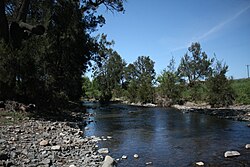Top Qs
Timeline
Chat
Perspective
Peel River (New South Wales)
River in New South Wales, Australia From Wikipedia, the free encyclopedia
Remove ads
Peel River, a watercourse that is part of the Namoi catchment within the Murray–Darling basin, is located in the North West Slopes and Plains district of New South Wales, Australia.
Remove ads
Course and features
Summarize
Perspective
The river rises on the northern slopes of the Liverpool Range, at the junction of the Great Dividing Range and Mount Royal Range, south of the village of Nundle, and flows generally north, west and north west and emerges into the Liverpool Plains near Tamworth. The Peel River is joined by thirteen tributaries, including the Cockburn River, and flows through Chaffey Dam before reaching its mouth at the confluence with the Namoi River; dropping 457 metres (1,499 ft) over its course of 210 kilometres (130 mi).[3]
From source to mouth, the river passes through or near the villages of Nundle, Woolomin and Piallamore.
The Peel River was first discovered by European settlers in 1818 by John Oxley and named by Oxley in honour of Sir Robert Peel, an important British politician at the time of its discovery by British settlers in Australia.[2]
At Tamworth, the river is crossed by the Main North line via the heritage-listed Tamworth rail bridge, completed in 1882.[4]
The famous Australian freshwater native fish Murray cod, Maccullochella peelii, was named after the Peel River by Major Mitchell, who sketched and scientifically described and named one of the numerous Murray cod his men caught from the river on his 1838 expedition.[citation needed]
Remove ads
See also
References
External links
Wikiwand - on
Seamless Wikipedia browsing. On steroids.
Remove ads


